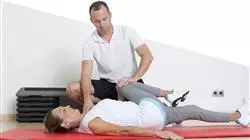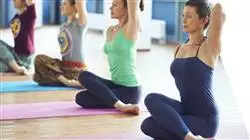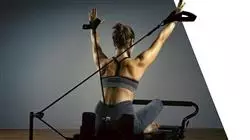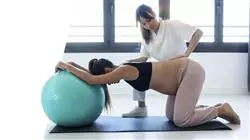University certificate
Scientific endorser

The world's largest faculty of sports science”
Introduction to the Program
You will actively implement the Pilates Method in your professional practice thanks to this 6-month University Expert”

The Pilates Method has gained popularity in the field of physical conditioning and rehabilitation due to its benefits in strengthening and stabilizing muscles and improving posture, flexibility, and overall body strength. These benefits have motivated physical trainers to incorporate this activity into their sessions.
In this sense, the evolution of the method itself entails continuous updating by the professionals. In this sense, TECH has developed this University Expert of 450 teaching hours that leads the graduate to obtain a complete up-to-date on the Application of the Pilates Method.
This is a program that will lead students to delve into the levels of progression of this discipline and an analysis of the different types of existing Pilates, as well as the most suitable exercises for each person. All this, in addition with the Relearning system based on the reiteration of content, will allow the graduate to consolidate the most important concepts in a simple way.
In this context, this program provides the fitness expert with a variety of multimedia resources, such as detailed videos and real case studies, which will be hosted in a virtual library, accessible from any device with Internet access. Therefore, with no classroom attendance or fixed class schedules, this program is an ideal option for combining daily responsibilities with a quality academic proposal.
You will broaden your knowledge about the evolution of the Pilates Method, its improvements, modifications, and contributions to the field of physical training”
This Postgraduate diploma inApplication of the Pilates Method contains the most complete and up-to-date scientific program on the market. The most important features include:
- The development of practical cases presented by experts in Physiotherapy and specialists in Pilates
- The graphic, schematic, and practical content with which they are created, provide scientific and practical information on the disciplines that are essential for professional practice
- Practical exercises where the self-assessment process can be carried out to improve learning
- Its special emphasis on innovative methodologies
- Theoretical lessons, questions to the expert, debate forums on controversial topics, and individual reflection assignments
- Content that is accessible from any fixed or portable device with an Internet connection
You will delve into the differences between Classical and Modern Pilates, acquiring the skills necessary to apply both approaches effectively”
The program’s teaching staff includes professionals from sector who contribute their work experience to this educational program, as well as renowned specialists from leading societies and prestigious universities.
Its multimedia content, developed with the latest educational technology, will provide the professional with situated and contextual learning, i.e., a simulated environment that will provide an immersive education programmed to learn in real situations.
The design of this program focuses on Problem-Based Learning, by means of which the professional must try to solve the different professional practice situations that are presented throughout the academic course. For this purpose, the student will be assisted by an innovative interactive video system created by renowned experts.
You will delve, when and where you wish into the principles of the Pilates Method, its evolution, and the different levels of progression”

You will explore in detail the latest scientific evidence supporting the Pilates Method and the benefits for physical improvement”
Syllabus
This University Expert in the Application of the Pilates Method is designed for physical trainers interested in keeping up to date in this field. In this way, during the development of the program, professionals will receive a complete up-to-date on the organization of the sessions and the various existing typologies. Also, it will delve into the different types of breathing or the relevance of the Core in relation to the Pelvis. In addition, all this with pedagogical tools based on multimedia pills, specialized readings, and case studies.

With the Relearning method, you will discover a simpler and more efficient way to assimilate complex concepts in less time”
Module 1. Pilates Method
1.1. Joseph Pilates
1.1.1. Joseph Pilates
1.1.2. Books and postulates
1.1.3. Legacy
1.1.4. Origin of customized exercise
1.2. Background of the Pilates Method
1.2.1. References
1.2.2. Evolution
1.2.3. Current Situation
1.2.4. Conclusions
1.3. Method Evolution
1.3.1. Improvements and modifications
1.3.2. Contributions to the Pilates method
1.3.3. Therapeutic Pilates
1.3.4. Pilates and Physical Activity
1.4. Principles Pilates Method
1.4.1. Definition of Principles
1.4.2. Evolution of Principles
1.4.3. Progression levels
1.4.4. Conclusions
1.5. Classical versus Contemporary/Modern Pilates
1.5.1. Key points in Classical Pilates
1.5.2. Modern/Classical Pilates Analysis
1.5.3. Contributions of Modern Pilates
1.5.4. Conclusions
1.6. Pilates on the Floor and Pilates on Machines
1.6.1. Fundamentals of Floor Pilates
1.6.2. Evolution of Pilates on floor
1.6.3. Fundamentals of Pilates on Machines
1.6.4. Evolution of Pilates on Machines
1.7. Scientific Evidence
1.7.1. Scientific journals related to Pilates
1.7.2. Doctoral thesis on Pilates
1.7.3. Pilates Publications
1.7.4. Pilates applications
1.8. Orientations of the Pilates Method
1.8.1. National trends
1.8.2. International trends
1.8.3. Trend Analysis
1.8.4. Conclusions
1.9. Schools
1.9.1. Pilates Training Schools
1.9.2. Magazines
1.9.3. Evolution of pilates schools
1.9.4. Conclusions
1.10. Pilates Associations and Federations
1.10.1. Definitions
1.10.2. Benefits
1.10.3. Objectives
1.10.4. PMA
Module 2. Fundamentals of the Pilates Method
2.1. The different concepts of the method
2.1.1. The concepts according to Joseph Pilates
2.1.2. Evolution of Concepts
2.1.3. Subsequent generations
2.1.4. Conclusions
2.2. Breathing
2.2.1. The different types of breathing
2.2.2. Analysis of types of breathing
2.2.3. The Effects of breathing
2.2.4. Conclusions
2.3. Pelvis as the core of stability and movement
2.3.1. The Joseph Pilates Core
2.3.2. The Scientific Core
2.3.3. Anatomical basis
2.3.4. Core in recovery processes
2.4. The organization of the shoulder girdle
2.4.1. Anatomical Review
2.4.2. Shoulder Girdle Biomechanics
2.4.3. Pilates applications
2.4.4. Conclusions
2.5. The organization of lower limb movement
2.5.1. Anatomical Review
2.5.2. Biomechanics the Lower Limb
2.5.3. Pilates applications
2.5.4. Conclusions
2.6. The articulation of the spine
2.6.1. Anatomical Review
2.6.2. Biomechanics of the Spine
2.6.3. Pilates applications
2.6.4. Conclusions
2.7. Body segment alignments
2.7.1. Posture
2.7.2. Posture in Pilates
2.7.3. Segmental alignments
2.7.4. Muscle and fascial chains
2.8. Functional integration
2.8.1. Concept of functional Integration
2.8.2. Implications on different activities
2.8.3. The task
2.8.4. The Context
2.9. Fundamentals of Therapeutic Pilates
2.9.1. History of Therapeutic Pilates
2.9.2. Concepts in Therapeutic Pilates
2.9.3. Criteria in Therapeutic Pilates
2.9.4. Examples of injuries or pathologies
2.10. Pilates clásico y Pilates terapéutico
2.10.1. Differences between both methods
2.10.2. Justification
2.10.3. Progressions
2.10.4. Conclusions
Module 3. Methodology in the practice of the Pilates Method
3.1. The initial session
3.1.1. Initial Assessment
3.1.2. Informed Consent
3.1.3. Words and commands related to Pilates
3.1.4. Onset on the Pilates Method
3.2. Initial Assessment
3.2.1. Postural assessment
3.2.2. Flexibility assessment
3.2.3. Evaluación coordinativa
3.2.4. Session planning. Pilates card
3.3. Pilates class
3.3.1. Initial exercises
3.3.2. Student groupings
3.3.3. Positioning, voice, corrections
3.3.4. Resting
3.4. Student-patients
3.4.1. Pilates student typology
3.4.2. Personalized commitment
3.4.3. Student objectives
3.4.4. The choice of method
3.5. Exercise progressions and regressions
3.5.1. Introduction to progressions and regressions
3.5.2. Progressions
3.5.3. Regressions
3.5.4. The evolution of treatment
3.6. General protocol
3.6.1. A basic generalized protocol
3.6.2. Respect Pilates fundamentals
3.6.3. Protocol analysis
3.6.4. Protocol functions
3.7. Indications of the exercises
3.7.1. Characteristics of initial position
3.7.2. Contraindications of the exercises
3.7.3. Verbal, tactile aids
3.7.4. Class scheduling
3.8. The teacher/monitor
3.8.1. Student analysis
3.8.2. Types of teachers
3.8.3. Generation of an adequate environment
3.8.4. Student follow-up
3.9. The basic program
3.9.1. Pilates for beginners
3.9.2. Pilates for intermediates
3.9.3. Pilates for experts
3.9.4. Professional Pilates
3.10. Software for pilates studio
3.10.1. Main pilates studio software
3.10.2. Application for pilates practicing
3.10.3. Latest technology in the pilates studio
3.10.4. Most significant advances in Pilates studio

You will delve into the progressions and regressions of the exercises implemented in Pilates and the evolution of the treatment"
Postgraduate Diploma in Pilates Method Application
Dive into the exciting world of wellness and health with the Postgraduate Diploma in Pilates Method Application, an exceptional opportunity presented by TECH Global University. If you are looking for an innovative way to understand and apply the fundamental principles of Pilates, this program is designed especially for you. The Pilates Method has proven to be a versatile and effective discipline for improving strength, flexibility and body alignment. In this Postgraduate Diploma program, you will discover how to take Pilates to the next level, learning how to adapt it to the individual and specific needs of each client. One of the great advantages of this program is its online modality, which gives you the freedom to study on your own terms, without sacrificing educational quality. At TECH Global University, we understand the importance of offering flexible and accessible learning options without compromising academic excellence.
The best education is here with TECH
Through a combination of interactive resources, audiovisual material and reading content, you'll explore how to apply Pilates principles to address diverse client needs and goals. You'll learn how to design customized routines that target specific areas of the body, improve posture and relieve tension. The Postgraduate Diploma in Pilates Method Application will give you an in-depth understanding of how this approach can positively influence physical and mental health. Whether you want to work with athletes, seniors or those with special needs, this program will provide you with the skills you need to make a difference. If you're ready to stand out as a Pilates expert and make a significant impact on your clients' lives, this program is your gateway. Enroll now in the Postgraduate Diploma in Pilates Method Application and start forging a rewarding career in the world of health and wellness!







